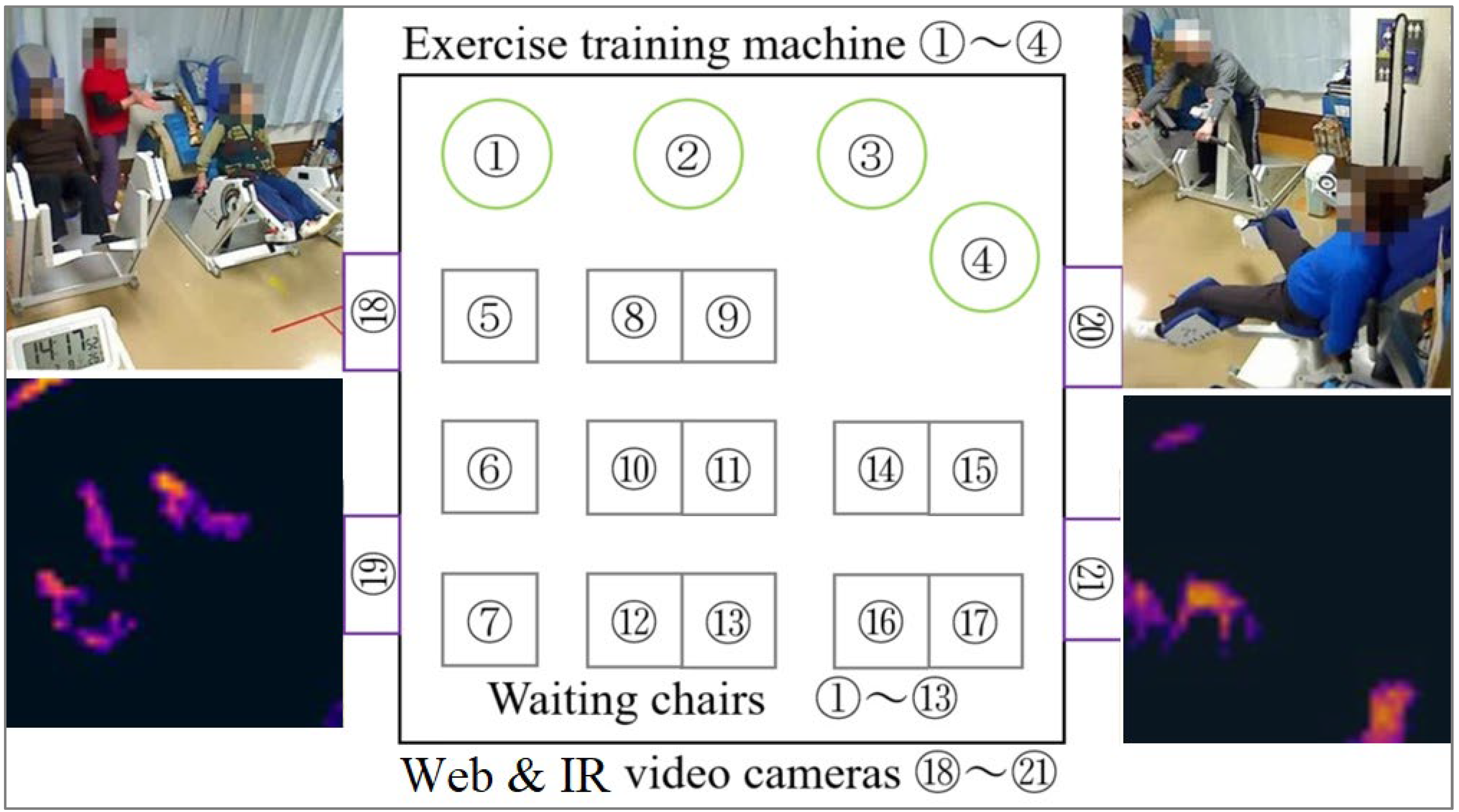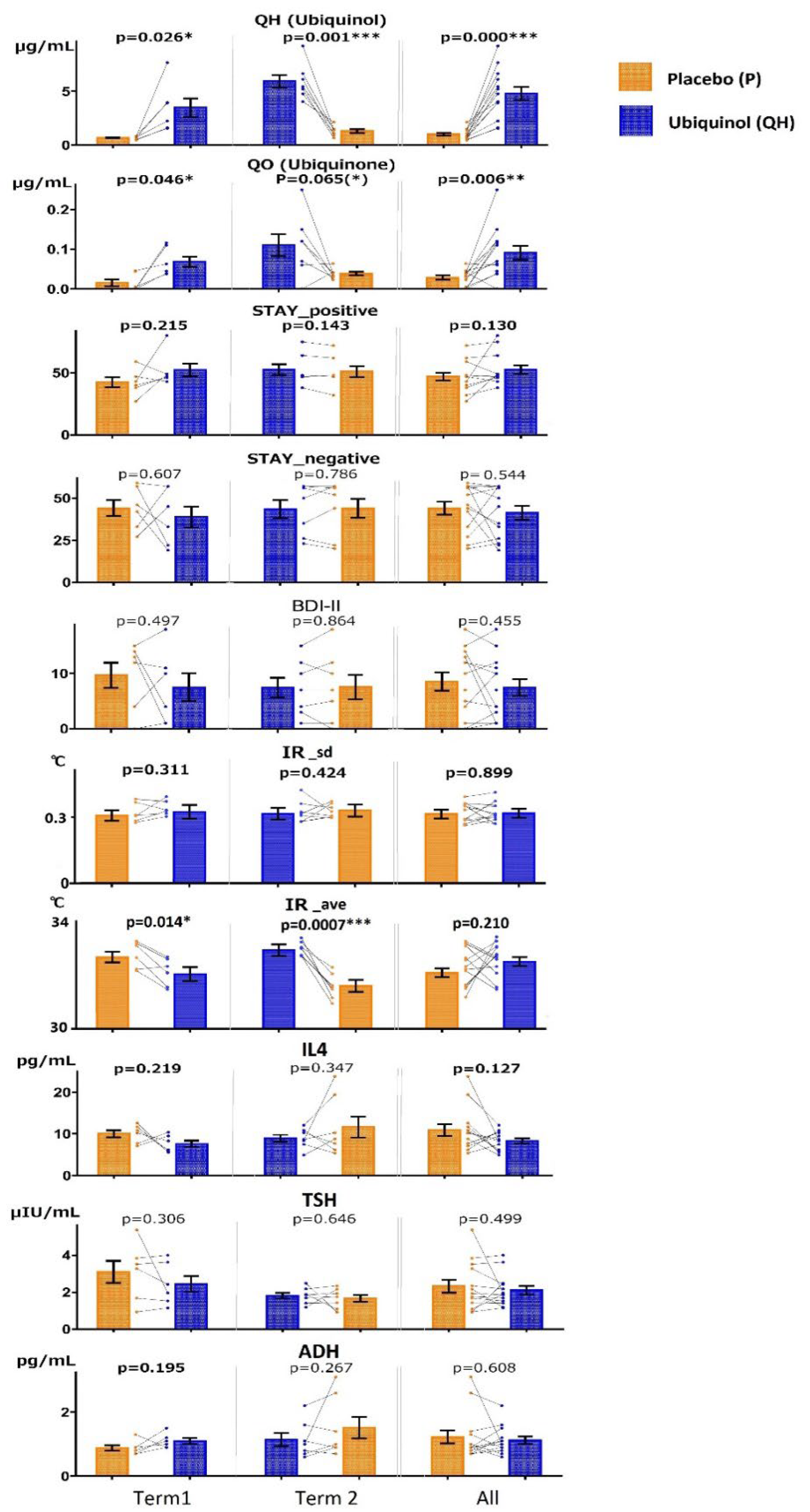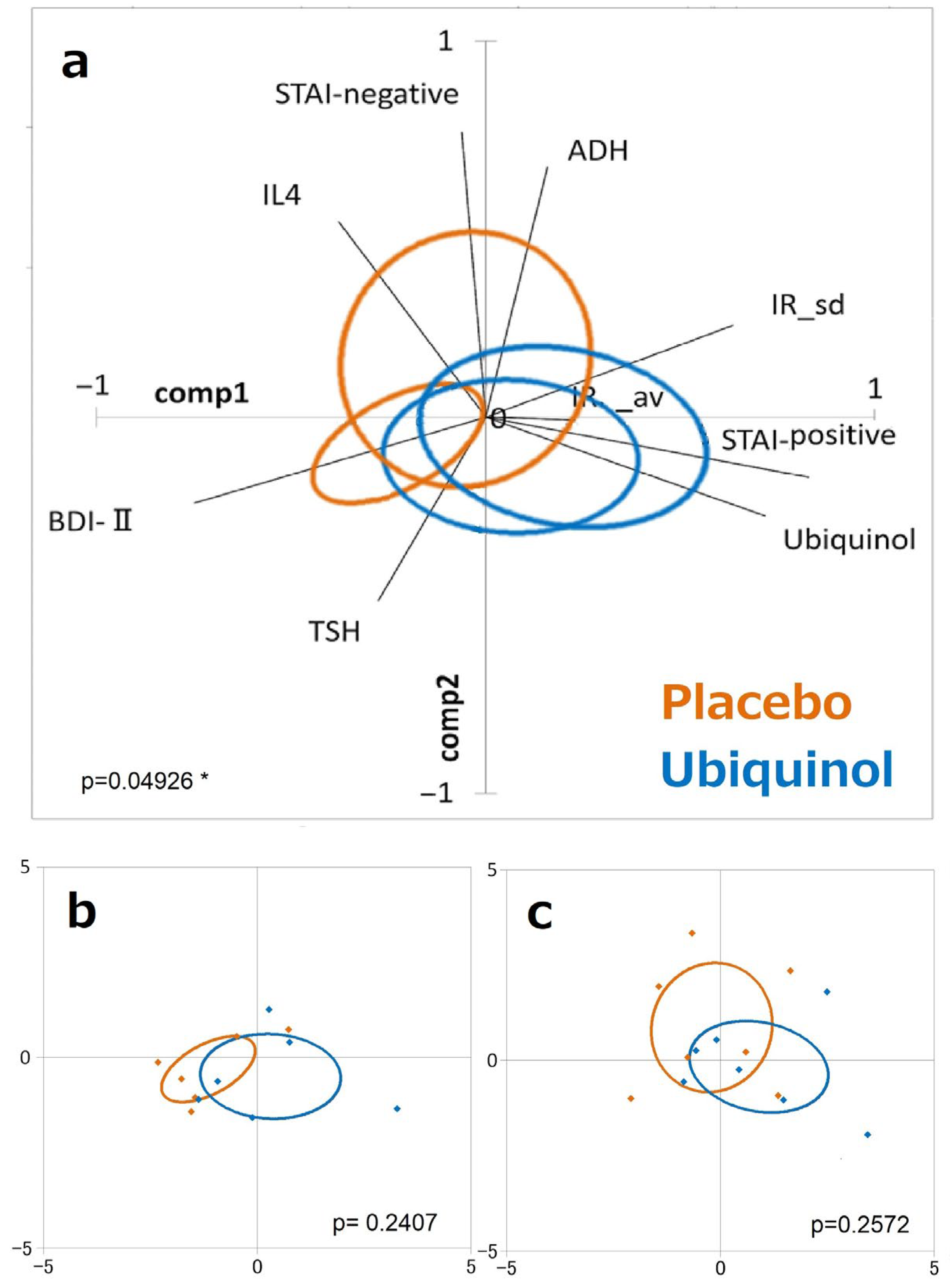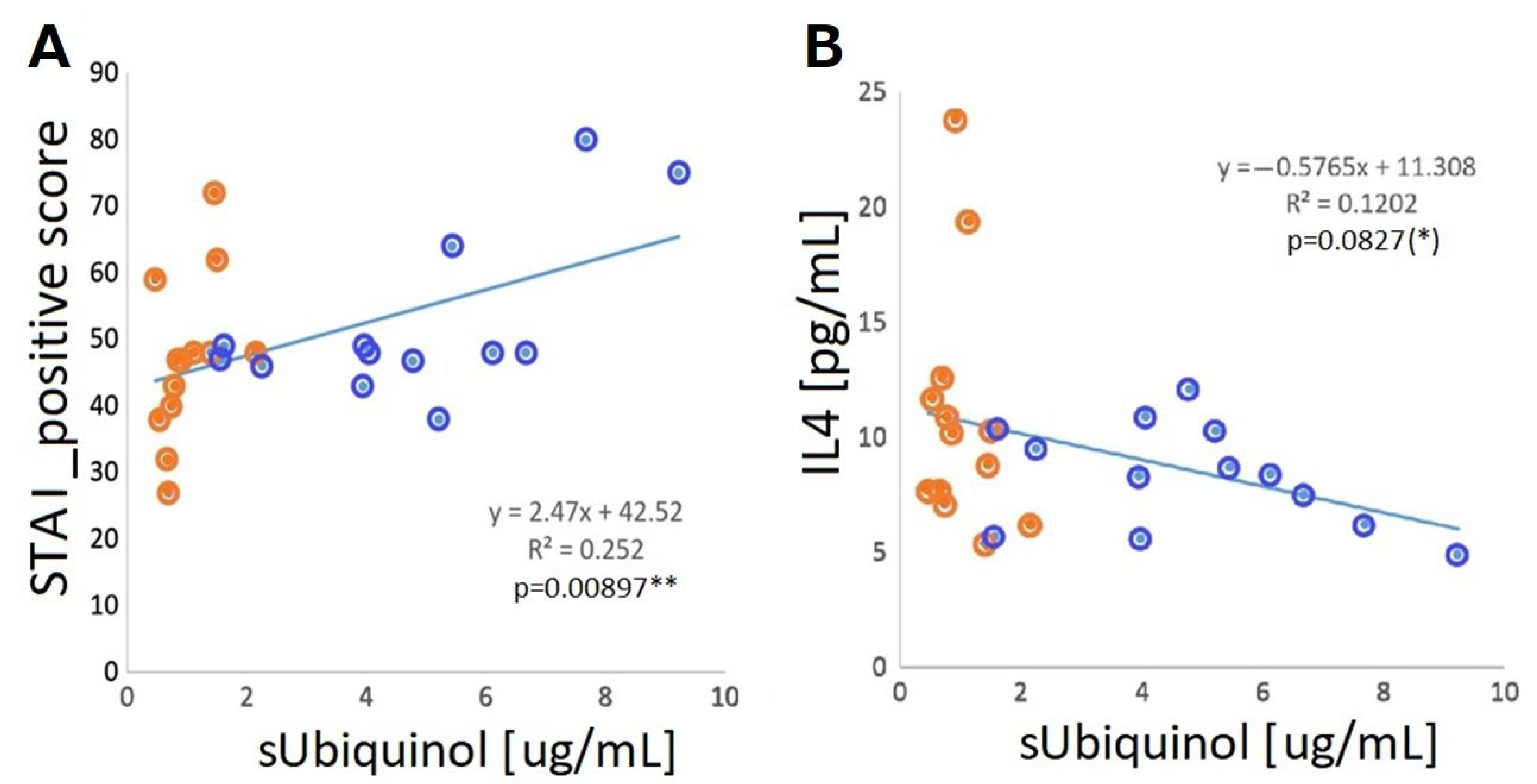The Effects of Ubiquinol Intake and Sociophysical Training on the Activation of Psychological and Infrared Camera-Measured Body Temperature Physiology and Blood Molecular Markers: A Pilot Study among Healthy Female Older Adults
Abstract
1. Introduction
1.1. Background of Ubiquinol Supplementation and Exercise in Older Adults
1.2. Design
2. Materials and Methods
2.1. Analyzed Subjects
2.2. Study Schedule
2.3. Exercise Training Program and Behavioral Indices
2.4. Psychological Questionnaires
2.5. Blood Collection and Molecular Measurement
2.6. Body Surface Temperature with an Infrared Camera Installed on the Wall of the Room
2.7. Multivariate Analysis
3. Results
3.1. Each Index Comparison between Two Group Conditions, Ubiquinol and Placebo
3.2. BOUQUET Reveals a Moderate Association of Ubiquinol Intake with “STAI-Positive” and a “BDI-II” Reveals a Weak Association with “IL-4”
3.3. Pearson’s Product–Moment Correlations with sUbiquinol Indicate a Significant Positive Relationship with STAI-Positive and a Weak Inverse Relationship with IL-4
3.4. Pearson’s Product–Moment Correlations with the Standard Deviation of IR Body Surface Temperatures Indicate a Significant Positive Relationship between Ubiquinol Intake and STAI-Positive and ADH
4. Discussion
5. Conclusions
Author Contributions
Funding
Institutional Review Board Statement
Informed Consent Statement
Data Availability Statement
Acknowledgments
Conflicts of Interest
References
- Lauretani, F.; Longobucco, Y.; Ferrari Pellegrini, F.; De Iorio, A.M.; Fazio, C.; Federici, R.; Gallini, E.; La Porta, U.; Ravazzoni, G.; Roberti, M.F.; et al. Comprehensive Model for Physical and Cognitive Frailty: Current Organization and Unmet Needs. Front. Psychol. 2020, 11, 569629. [Google Scholar] [CrossRef] [PubMed]
- Gu, Y.; Nieves, J.W.; Stern, Y.; Luchsinger, J.A.; Scarmeas, N. Combinación de Alimentos y Riesgo de Enfermedad de Alzheimer. Una Dieta Protectora. Arch. Neurol. 2010, 67, 699–706. [Google Scholar] [CrossRef] [PubMed]
- Wada, H.; Goto, H.; Hagiwara, S.I.; Yamamoto, Y. Redox Status of Coenzyme Q10 Is Associated with Chronological Age. J. Am. Geriatr. Soc. 2007, 55, 1141–1142. [Google Scholar] [CrossRef] [PubMed]
- Maes, M.; Mihaylova, I.; Kubera, M.; Uytterhoeven, M.; Vrydags, N.; Bosmans, E. Lower Plasma Coenzyme Q10 in Depression: A Marker for Treatment Resistance and Chronic Fatigue in Depression and a Risk Factor to Cardiovascular Disorder in That Illness. Neuroendocrinol. Lett. 2009, 30, 462–469. [Google Scholar] [PubMed]
- Mantzavinos, V.; Alexiou, A. Biomarkers for Alzheimer’s Disease Diagnosis. Curr. Alzheimer Res. 2017, 14, 1149–1154. [Google Scholar] [CrossRef]
- Frontiñán-Rubio, J.; Rabanal-Ruiz, Y.; Durán-Prado, M.; Alcain, F.J. The Protective Effect of Ubiquinone against the Amyloid Peptide in Endothelial Cells Is Isoprenoid Chain Length-Dependent. Antioxidants 2021, 10, 1806. [Google Scholar] [CrossRef]
- Stough, C.; Nankivell, M.; Camfield, D.A.; Perry, N.L.; Pipingas, A.; Macpherson, H.; Wesnes, K.; Ou, R.; Hare, D.; De Haan, J.; et al. COQ10 and Cognition a Review and Study Protocol for a 90-Day Randomized Controlled Trial Investigating the Cognitive Effects of Ubiquinol in the Healthy Elderly. Front. Aging Neurosci. 2019, 11, 103. [Google Scholar] [CrossRef] [PubMed]
- Shetty, R.A.; Forster, M.J.; Sumien, N. Coenzyme Q10 Supplementation Reverses Age-Related Impairments in Spatial Learning and Lowers Protein Oxidation. Age 2013, 35, 1821–1834. [Google Scholar] [CrossRef]
- Ali, A.A.; Abo El-Ella, D.M.; El-Emam, S.Z.; Shahat, A.S.; El-Sayed, R.M. Physical & Mental Activities Enhance the Neuroprotective Effect of Vinpocetine & Coenzyme Q10 Combination against Alzheimer & Bone Remodeling in Rats. Life Sci. 2019, 229, 21–35. [Google Scholar] [CrossRef]
- Quan, H.; Koltai, E.; Suzuki, K.; Aguiar, A.S.; Pinho, R.; Boldogh, I.; Berkes, I.; Radak, Z. Exercise, Redox System and Neurodegenerative Diseases. Biochim. Biophys. Acta Mol. Basis Dis. 2020, 1866, 165778. [Google Scholar] [CrossRef]
- Pluchino, N.; Russo, M.; Santoro, A.N.; Litta, P.; Cela, V.; Genazzani, A.R. Steroid Hormones and BDNF. Neuroscience 2013, 239, 271–279. [Google Scholar] [CrossRef] [PubMed]
- Rawlings, A.M.; Sharrett, A.R.; Albert, M.S.; Coresh, J.; Windham, B.G.; Power, M.C.; Knopman, D.S.; Walker, K.; Burgard, S.; Mosley, T.H.; et al. The Association of Late-Life Diabetes Status and Hyperglycemia with Incident Mild Cognitive Impairment and Dementia: The ARIC Study. Diabetes Care 2019, 42, 1248–1264. [Google Scholar] [CrossRef] [PubMed]
- Tan, Z.S.; Beiser, A.; Vasan, R.S.; Au, R.; Auerbach, S.; Kiel, D.P.; Wolf, P.A.; Seshadri, S. Thyroid Function and the Risk of Alzheimer Disease: The Framingham Study. Arch. Intern. Med. 2008, 168, 1514–1520. [Google Scholar] [CrossRef] [PubMed]
- Decourt, B.; Lahiri, D.K.; Sabbagh, M.N. Targeting Tumor Necrosis Factor Alpha for Alzheimer’s Disease. Curr. Alzheimer Res. 2017, 14, 412–425. [Google Scholar] [CrossRef] [PubMed]
- Swaab, D.F.; Bao, A.M.; Lucassen, P.J. The Stress System in the Human Brain in Depression and Neurodegeneration. Ageing Res. Rev. 2005, 4, 141–194. [Google Scholar] [CrossRef] [PubMed]
- Moussa, C.; Hebron, M.; Huang, X.; Ahn, J.; Rissman, R.A.; Aisen, P.S.; Turner, R.S. Resveratrol Regulates Neuro-Inflammation and Induces Adaptive Immunity in Alzheimer’s Disease. J. Neuroinflamm. 2017, 14, 1. [Google Scholar] [CrossRef] [PubMed]
- Hamilton, K.; Harvey, J. The Neuronal Actions of Leptin and the Implications for Treating Alzheimer’s Disease. Pharmaceuticals 2021, 14, 52. [Google Scholar] [CrossRef]
- Polat, M.; Polat, Y.; Akbulut, T.; Cinar, V.; Marangoz, I. The Effects of Trainings Applied with CoQ10 and Zinc Supplementation on the Thyroid Hormone Metabolism in Soccer Players. Biomed. Res. India 2017, 28, 7070–7075. [Google Scholar]
- Maruoka, H.; Tanaka, K.-I.; Takayanagi, M.; Zenda, M.; Ogawa, A. The Influence of the Different Exercise Length on Alveolar and Cytokine The Analysis of Chronic Obstructive Pulmonary Disease (COPD) and Skeletal Muscle Atrophy Model Mice. J. Clin.Physiol. 2021, 51, 23–34. [Google Scholar]
- Drury, R.; Matos, M.; Lee, K.H.; Kirby, J.N.; Doty, J.R.; Petrocchi, N.; Gilbert, P. The Current and Future Role of Heart Rate Variability for Assessing and Training Compassion. Front. Public Health 2017, 5, 40. [Google Scholar] [CrossRef]
- Abdollahzad, H.; Aghdashi, M.A.; Asghari Jafarabadi, M.; Alipour, B. Effects of Coenzyme Q10 Supplementation on Inflammatory Cytokines (TNF-α, IL-6) and Oxidative Stress in Rheumatoid Arthritis Patients: A Randomized Controlled Trial. Arch. Med. Res. 2015, 46, 527–533. [Google Scholar] [CrossRef] [PubMed]
- Hosoe, K.; Kitano, M.; Kishida, H.; Kubo, H.; Fujii, K.; Kitahara, M. Study on Safety and Bioavailability of Ubiquinol (Kaneka QHTM) after Single and 4-Week Multiple Oral Administration to Healthy Volunteers. Regul. Toxicol. Pharmacol. 2007, 47, 19–28. [Google Scholar] [CrossRef] [PubMed]
- Martucci, A.; Reurean-Pintilei, D.; Manole, A. Bioavailability and Sustained Plasma Concentrations of CoQ10 in Healthy Volunteers by a Novel Oral Timed-Release Preparation. Nutrients 2019, 11, 527. [Google Scholar] [CrossRef] [PubMed]
- Peixoto De Barcelos, I.; Haas, R.H. Biology CoQ10 and Aging. Biology 2019, 8, 28. [Google Scholar] [CrossRef]
- Koshiba, M.; Mimura, K.; Sugiura, Y.; Okuya, T.; Senoo, A.; Ishibashi, H.; Nakamura, S. Reading Marmoset Behavior “semantics” under Particular Social Context by Multi-Parameters Correlation Analysis. Prog. Neuropsychopharmacol. Biol. Psychiatry 2011, 35, 1499–1504. [Google Scholar] [CrossRef] [PubMed]
- Koshiba, M.; Shirakawa, Y.; Mimura, K.; Senoo, A.; Karino, G.; Nakamura, S. Familiarity Perception Call Elicited under Restricted Sensory Cues in Peer-Social Interactions of the Domestic Chick. PLoS ONE 2013, 8, 58847. [Google Scholar] [CrossRef] [PubMed][Green Version]
- Koshiba, M.; Karino, G.; Mimura, K.; Nakamura, S.; Yui, K.; Kunikata, T.; Yamanouchi, H. Psycho-Cognitive Intervention for ASD from Cross-Species Behavioral Analyses of Infants, Chicks and Common Marmosets. CNS Neurol. Disord. Drug Targets 2016, 15, 578–586. [Google Scholar] [CrossRef]
- Koshiba, M.; Senoo, A.; Mimura, K.; Shirakawa, Y.; Karino, G.; Obara, S.; Ozawa, S.; Sekihara, H.; Fukushima, Y.; Ueda, T.; et al. A Cross-Species Socio-Emotional Behaviour Development Revealed by a Multivariate Analysis. Sci. Rep. 2013, 3, 2630. [Google Scholar] [CrossRef]
- Koshiba, M.; Watarai-Senoo, A.; Karino, G.; Ozawa, S.; Kamei, Y.; Honda, Y.; Tanaka, I.; Kodama, T.; Usui, S.; Tokuno, H. A Susceptible Period of Photic Day-Night Rhythm Loss in Common Marmoset Social Behavior Development. Front. Behav. Neurosci. 2021, 14, 539411. [Google Scholar] [CrossRef]
- Mimura, K.; Senoo, A.; Fujii, K.; Shimizu, T.; Saga, T.; Tanaka, I.; Honda, Y.; Tokuno, H.; Usui, S.; Kodama, T.; et al. Multivariate Correlation Analysis Suggested High Ubiquinol and Low Ubiquinone in Plasma Promoted Primate’s Social Motivation and IR Detected Lower Body Temperature. J. Clin. Toxicol. 2013, 3, 160. [Google Scholar] [CrossRef]
- Mimura, K. A Sensitive Period of Peer-Social Learning. J. Clin. Toxicol. 2013, 3, 1000158. [Google Scholar] [CrossRef]
- Mimura, K.; Nakamura, S.; Koshiba, M. A Flexion Period for Attachment Formation in Isolated Chicks to Unfamiliar Peers Visualized in a Developmental Trajectory Space through Behavioral Multivariate Correlation Analysis. Neurosci. Lett. 2013, 547, 70–75. [Google Scholar] [CrossRef] [PubMed]
- Koshiba, M.; Karino, G.; Senoo, A.; Mimura, K.; Shirakawa, Y.; Fukushima, Y.; Obara, S.; Sekihara, H.; Ozawa, S.; Ikegami, K.; et al. Peer Attachment Formation by Systemic Redox Regulation with Social Training after a Sensitive Period. Sci. Rep. 2013, 3, 2503. [Google Scholar] [CrossRef]
- Karino, G.; Shukuya, M.; Nakamura, S.; Murakoshi, T.; Kunikata, T.; Yamanouchi, H.; Koshiba, M. Common Marmosets Develop Age-Specific Peer Social Experiences That May Affect Their Adult Body Weight Adaptation to Climate. Stress Brain Behavior. 2015, 3, e019001. [Google Scholar]
- Koshiba, M.; Senoo, A.; Karino, G.; Shirakawa, Y.; Mimura, K.; Sagawa, T.; Tsugawa, W.; Sode, K.; Nakamura, S. Blood Glucose Dependence on Emotional Behaviors and Body Surface Temperatures in Common Marmoset’s Socio-Psychological Learning with Peers for “development of Human-Environment Interface by Sensing and Multivariate Analysis of Bio-Ecosystem”. ECS Trans. 2012, 50, 9. [Google Scholar] [CrossRef]
- Karino, G.; Senoo, A.; Kunikata, T.; Kamei, Y.; Yamanouchi, H.; Nakamura, S.; Shukuya, M.; Colman, R.J.; Koshiba, M. Inexpensive Home Infrared Living/Environment Sensor with Regional Thermal Information for Infant Physical and Psychological Development. Int. J. Environ. Res. Public Health 2020, 17, 6844. [Google Scholar] [CrossRef] [PubMed]
- Stephanos Ioannou, V.G. and A.M. Thermal Infrared Imaging in Psychophysiology Potentialities and Limits Enhanced Reader. Psychophysiology 2014, 51, 951–963. [Google Scholar] [CrossRef]
- Kimura, K.; Obuchi, S.; Arai, T.; Nagasawa, H.; Shiba, Y.; Watanabe, S.; Kojima, M. The Influence of Short-Term Strength Training on Health-Related Quality of Life and Executive Cognitive Function. J. Physiol. Anthropol. 2010, 29, 95–101. [Google Scholar] [CrossRef]
- Spielberger, C.D.; Gorsuch, R.L.; Lushene, R.; Vagg, P.R.; Jacobs, G.A. State-Trait-Anxiety-Inventory for Adults Self-Evaluation Questionnaire STAI Form Y-1 Nad Form Y-2 1968; Mind Garden: Redwood City, CA, USA, 1977; Volume 5. [Google Scholar]
- Steer, R.A.; Rissmiller, D.J.; Beck, A.T. Use of the Beck Depression Inventory-II with Depressed Geriatric Inpatients. Behav. Res. Ther. 2000, 38, 311–318. [Google Scholar] [CrossRef]
- Shirakawa, Y. Peer-Social Network Development Revealed by the Brain Multivariate Correlation Map with 10 Monoamines and 11 Behaviors. J. Clin. Toxicol. 2013, 3, 1000161. [Google Scholar] [CrossRef]
- Duignan, J. A Dictionary of Business Research Methods; Oxford University Press: Oxford, UK, 2016; ISBN 9780191792236. [Google Scholar]
- Hernández-Camacho, J.D.; Bernier, M.; López-Lluch, G.; Navas, P. Coenzyme Q10 Supplementation in Aging and Disease. Front. Physiol. 2018, 9, 44. [Google Scholar] [CrossRef] [PubMed]
- Mcphee, J.S.; French, D.P.; Jackson, D.; Nazroo, J.; Pendleton, N.; Degens, H. Physical Activity in Older Age: Perspectives for Healthy Ageing and Frailty. Biogerontology 2016, 17, 567–580. [Google Scholar] [CrossRef] [PubMed]
- Santiago, H.P.; Leite, L.H.R.; Lima, P.M.A.; Fóscolo, D.R.C.; Natali, A.J.; Prímola-Gomes, T.N.; Szawka, R.E.; Coimbra, C.C. Effects of Physical Training on Hypothalamic Neuronal Activation and Expressions of Vasopressin and Oxytocin in SHR after Running until Fatigue. Pflugers Arch. 2024, 476, 365–377. [Google Scholar] [CrossRef] [PubMed]
- Koshiba, M.; Nakamura, S.; Mimura, K.; Senoo, A.; Karino, G.; Amemiya, S.; Miyaji, T.; Kunikata, T.; Yamanouchi, H. Socio-Emotional Development Evaluated by Behaviour Output Analysis for Quantitative Emotional State Translation (BOUQUET): Towards Early Diagnosis of Individuals with Developmental Disorders. OA Autism. 2013, 1, 18. [Google Scholar] [CrossRef]
- Senoo, A.; Okuya, T.; Sugiura, Y.; Mimura, K.; Honda, Y.; Tanaka, I.; Kodama, T.; Tokuno, H.; Yui, K.; Nakamura, S.; et al. Effects of Constant Daylight Exposure during Early Development on Marmoset Psychosocial Behavior. Prog. Neuropsychopharmacol. Biol. Psychiatry 2011, 35, 1493–1498. [Google Scholar] [CrossRef] [PubMed]
- Kaushik, D.K.; Pasetto, L.; Colangelo, A.M.; De La Fuente, A.G.; Mayne, K.; White, J.A.; Mcmurran, C.E.; Rivera, F.J. Aging and Neurodegenerative Disease: Is the Adaptive Immune System a Friend or Foe? Front. Aging Neurosci. 2020, 12, 572090. [Google Scholar] [CrossRef]
- Kelso, G.F.; Porteous, C.M.; Coulter, C.V.; Hughes, G.; Porteous, W.K.; Ledgerwood, E.C.; Smith, R.A.J.; Murphy, M.P. Selective Targeting of a Redox-Active Ubiquinone to Mitochondria within Cells: Antioxidant and Antiapoptotic Properties. J. Biol. Chem. 2001, 276, 4588–4596. [Google Scholar] [CrossRef]
- Mavani, G.P.; DeVita, M.V.; Michelis, M.F. A Review of the Nonpressor and Nonantidiuretic Actions of the Hormone Vasopressin. Front. Med. 2015, 2, 19. [Google Scholar] [CrossRef]
- Todd Pearson, J.; Ramchandra, R.; Simões Colombari, D.A.; Allen Crone, S.; Proczka, M.; Przybylski, J.; Cudnoch-Jędrzejewska, A.; Szczepan, E.; Żera, T. Vasopressin and Breathing: Review of Evidence for Respiratory Effects of the Antidiuretic Hormone. Physiol 2021, 12, 744177. [Google Scholar] [CrossRef]
- Harada, N.; Shigemura, J.; Tanichi, M.; Kawaida, K.; Takahashi, S. Mental Health and Psychological Impacts from the 2011 Great East Japan Earthquake Disaster: A Systematic Literature Review. Disaster Mil. Med. 2015, 1, 17. [Google Scholar] [CrossRef]
- Diaz-castro, J.; Moreno-fernandez, J.; Chirosa, I.; Chirosa, L.J.; Guisado, R.; Ochoa, J.J. Beneficial E Ff Ect of Ubiquinol on Hematological and Inflammatory Signaling during Exercise. Nutrients 2020, 12, 424. [Google Scholar] [CrossRef] [PubMed]
- Frodl, T.; Amico, F. Is There an Association between Peripheral Immune Markers and Structural/Functional Neuroimaging Findings? Prog. Neuropsychopharmacol. Biol. Psychiatry 2014, 48, 295–303. [Google Scholar] [CrossRef] [PubMed]
- Zhang, J.; Rong, P.; Zhang, L.; He, H.; Zhou, T.; Fan, Y.; Mo, L.; Zhao, Q.; Han, Y.; Li, S.; et al. IL4-Driven Microglia Modulate Stress Resilience through BDNF-Dependent Neurogenesis. Sci. Adv. 2021, 7, eabb9888. [Google Scholar] [CrossRef] [PubMed]
- Talukdar, A.; Sharma, K.A.; Rai, R.; Deka, D.; Rao, D.N. Effect of Coenzyme Q10 on Th1/Th2 Paradigm in Females with Idiopathic Recurrent Pregnancy Loss. Am. J. Reprod. Immunol. 2015, 74, 169–180. [Google Scholar] [CrossRef]
- Moran, J.M.; Takahashi, M.; Kinoshita, T.; Maruyama, K.; Suzuki, T. CYP7A1, NPC1L1, ABCB1, and CD36 Polymorphisms Associated with Coenzyme Q 10 Availability Affect the Subjective Quality of Life Score (SF-36) after Long-Term CoQ 10 Supplementation in Women. Nutrients 2022, 14, 2579. [Google Scholar] [CrossRef]
- Deng, Z.; Guo, L.; Chen, X.; Wu, W. Smart Wearable Systems for Health Monitoring. Sensors 2023, 23, 2479. [Google Scholar] [CrossRef] [PubMed]
- Vaghasiya, J.V.; Mayorga-Martinez, C.C.; Pumera, M. Wearable Sensors for Telehealth Based on Emerging Materials and Nanoarchitectonics. npj Flex. Electron. 2023, 7, 26. [Google Scholar] [CrossRef]
- Zhao, Y.; Bergmann, J.H.M. Non-Contact Infrared Thermometers and Thermal Scanners for Human Body Temperature Monitoring: A Systematic Review. Sensors 2023, 23, 7439. [Google Scholar] [CrossRef]
- Jerem, P.; Jenni-Eiermann, S.; McKeegan, D.; McCafferty, D.J.; Nager, R.G. Eye Region Surface Temperature Dynamics during Acute Stress Relate to Baseline Glucocorticoids Independently of Environmental Conditions. Physiol. Behav. 2019, 210, 112627. [Google Scholar] [CrossRef]
- Bao, A.M.; Meynen, G.; Swaab, D.F. The Stress System in Depression and Neurodegeneration: Focus on the Human Hypothalamus. Brain Res. Rev. 2008, 57, 531–553. [Google Scholar] [CrossRef]
- Grases, G.; Colom, M.A.; Fernandez, R.A.; Costa-Bauzá, A.; Grases, F. Evidence of Higher Oxidative Status in Depression and Anxiety. Oxidative Med. Cell. Longev. 2014, 2014, 430216. [Google Scholar] [CrossRef] [PubMed]
- Johri, A. Molecular Sciences Disentangling Mitochondria in Alzheimer’s Disease. Int. J. Mol. Sci. 2021, 22, 11520. [Google Scholar] [CrossRef] [PubMed]
- Testai, L.; Martelli, A.; Flori, L.; Cicero, A.F.G.; Colletti, A. Coenzyme Q 10: Clinical Applications beyond Cardiovascular Diseases. Nutrients 2021, 13, 1697. [Google Scholar] [CrossRef] [PubMed]
- Toschi, A.; Severi, A.; Coletti, D.; Catizone, A.; Musarò, A.; Molinaro, M.; Nervi, C.; Adamo, S.; Scicchitano, B.M.; Sciences, O. Skeletal Muscle Regeneration in Mice Is Stimulated by Local Overexpression of V1a-Vasopressin Receptor. Mol. Endocrinol. 2011, 25, 1661–1673. [Google Scholar] [CrossRef] [PubMed][Green Version]
- Gorlova, A.; Svirin, E.; Pavlov, D.; Cespuglio, R.; Proshin, A.; Schroeter, C.A.; Lesch, K.-P.; Strekalova, T.; Anokhin, P.K. Understanding the Role of Oxidative Stress, Neuroinflammation and Abnormal Myelination in Excessive Aggression Associated with Depression: Recent Input from Mechanistic Studies. Int. J. Mol. Sci. 2023, 24, 915. [Google Scholar] [CrossRef] [PubMed]
- Luis García-Giménez, J.; Chandra Tripathi, S.; John Percy, A.; Dhama, K.; Munjal, A.; Hmn, I.; Latheef, S.K.; Dadar, M.; Abdul Samad, H.; Khandia, R.; et al. Biomarkers in Stress Related Diseases/Disorders: Diagnostic, Prognostic, and Therapeutic Values. Front. Mol. Biosci. 2019, 6, 91. [Google Scholar] [CrossRef]





| Marker | Molecule in Blood Serum | Pearson’s Product–Moment Correlation with sUbiquinol | ||
|---|---|---|---|---|
| R | t | p | ||
| sUbiquinol | Ubiquinol: reduced coenzyme Q10 | - | - | - |
| sUbiquinone | Ubiquinone: oxidized coenzyme Q10 | 0.798 | 6.492 | 0.000 *** |
| TSH | Thyrotropin | −0.180 | 0.898 | 0.378 |
| IL-4 | Interleukin 4 | −0.347 | −1.811 | 0.0827 (*) |
| ADH | Antidiuretic hormone (vasopressin) | −0.015 | 0.073 | 0.942 |
| Marker | Infrared intensity | |||
| IR_sd | Body surface temperature: standard deviation | 0.256 | 1.295 | 0.208 |
| IR_ave | Body surface temperature: average | 0.329 | 1.7056 | 0.101 |
| Marker | Psychological questionnaire | |||
| STAI-positive | State–Trait Anxiety Inventory (positive mood) | 0.502 | 2.844 | 0.00897 ** |
| STAI-negative | State–Trait Anxiety Inventory (negative mood) | −0.226 | 1.137 | 0.267 |
| BDI-II | Beck Depression Inventory-II | −0.277 | 1.410 | 0.171 |
| Marker | Molecule in Blood Serum | Pearson’s Product–Moment Correlation with IR-sd | ||
|---|---|---|---|---|
| R | t | p | ||
| sUbiquinol | Ubiquinol | - | - | - |
| sUbiquinone | Ubiquinone | 0.186 | 0.930 | 0.362 |
| TSH | Thyrotropin | 0.0454 | 0.223 | 0.825 |
| IL-4 | Interleukin 4 | −0.207 | −1.036 | 0.310 |
| ADH | Antidiuretic hormone (vasopressin) | 0.524 | 3.014 | 0.006 ** |
| Marker | Infrared intensity | |||
| IR_sd | Standard Deviation | - | - | - |
| IR_ave | Average | 0.0985 | 0.485 | 0.632 |
| Marker | Psychological questionnaire | |||
| STAI-positive | State–Trait Anxiety Inventory (positive mood) | 0.412 | 2.221 | 0.036 * |
| STAI-negative | State–Trait Anxiety Inventory (negative mood) | 0.00601 | 0.0295 | 0.977 |
| BDI-II | Beck Depression Inventory-II | −0.321 | −1.666 | 0.109 |
Disclaimer/Publisher’s Note: The statements, opinions and data contained in all publications are solely those of the individual author(s) and contributor(s) and not of MDPI and/or the editor(s). MDPI and/or the editor(s) disclaim responsibility for any injury to people or property resulting from any ideas, methods, instructions or products referred to in the content. |
© 2024 by the authors. Licensee MDPI, Basel, Switzerland. This article is an open access article distributed under the terms and conditions of the Creative Commons Attribution (CC BY) license (https://creativecommons.org/licenses/by/4.0/).
Share and Cite
Ota, M.; Hariyama, M.; Colman, R.; Koshiba, M. The Effects of Ubiquinol Intake and Sociophysical Training on the Activation of Psychological and Infrared Camera-Measured Body Temperature Physiology and Blood Molecular Markers: A Pilot Study among Healthy Female Older Adults. Appl. Sci. 2024, 14, 2366. https://doi.org/10.3390/app14062366
Ota M, Hariyama M, Colman R, Koshiba M. The Effects of Ubiquinol Intake and Sociophysical Training on the Activation of Psychological and Infrared Camera-Measured Body Temperature Physiology and Blood Molecular Markers: A Pilot Study among Healthy Female Older Adults. Applied Sciences. 2024; 14(6):2366. https://doi.org/10.3390/app14062366
Chicago/Turabian StyleOta, Makoto, Masanori Hariyama, Ricki Colman, and Mamiko Koshiba. 2024. "The Effects of Ubiquinol Intake and Sociophysical Training on the Activation of Psychological and Infrared Camera-Measured Body Temperature Physiology and Blood Molecular Markers: A Pilot Study among Healthy Female Older Adults" Applied Sciences 14, no. 6: 2366. https://doi.org/10.3390/app14062366
APA StyleOta, M., Hariyama, M., Colman, R., & Koshiba, M. (2024). The Effects of Ubiquinol Intake and Sociophysical Training on the Activation of Psychological and Infrared Camera-Measured Body Temperature Physiology and Blood Molecular Markers: A Pilot Study among Healthy Female Older Adults. Applied Sciences, 14(6), 2366. https://doi.org/10.3390/app14062366








